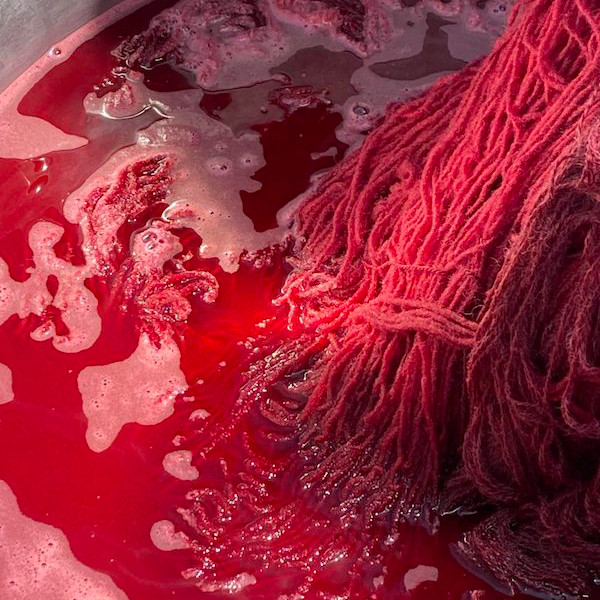We get so many questions about cochineal, from techniques to color fastness to “what does it smell like?”
The questions are frequent so we’re hoping many of you will send them in so Kathy can properly answer and give you some help!
Today’s question came in from one of our favorite textile artists, Abigail Doan of Lost in Fiber.
Abigail: I was recently chatting with my textile artist mother over Labor Day weekend about recent natural dye experiments she has been doing, and she shared that the color that she has yielded from cochineal dye has often varied.
I know from reading your site (and Amy DuFault’s blog post), that Botanical Colors’ cochineal process typically starts with the silvery purple bugs. This is what my mother prefers, of course, but if one starts with reddish extract powder – is the hue intensity or value compromised at all?
With contemporary dyers often knowing what they do already, why would anyone even start with the powder extract – outside of the availability or cost issue perhaps? In the past, cochineal bugs went through a period of being difficult to find – or rather, some folks had the perception that the powdered extract was just fine to work with but others believed that the color yielded might often not be as desirable or authentic.
What are your thoughts on this front and might you shed light on the varieties available?
Kathy: Cochineal is one of the only natural red colorants that is approved for FDA use in food and cosmetics so it comes in a variety of preparations, in raw or insect form and in a finely processed powder or liquid. The insects themselves are sorted into several grades and the extract that is made from them can range from nearly black all the way to a vivid red. Textile dyers usually purchase the insects as they are about 1/5th the price per pound of the extracts. However, the extracts can be extremely strong, with up to 4 times the amount of carminic acid as the insects, so there’s a bit of a tradeoff.
Carminic acid is the bright red color of cochineal and depending on how pure the extract is, may be used in cosmetics or as a food color. A few years ago everyone freaked out to learn that Starbuck’s Strawberry Frappucino was colored with carmine, or cochineal, but carmine has been used as a food color since the 1960s. It’s only recently that the FDA ruled that is must be disclosed as a color ingredient as people are becoming much more sensitive to dyestuffs, even natural ones, and can experience allergic reactions from exposure to carminic acid.
When working with commercial dyers, we only use extracts. It’s just impossible to have a large dye house grinding and soaking their own bugs in order to start a dye job, plus extracts allow for a closer color match in subsequent dye lots.
Cochineal was very difficult to obtain about 10 years ago. The growers were being underpaid and so in protest they switched from raising cochineal to growing asparagus and other specialty crops. As a result, cochineal extract was priced at $900 per kg for several years as they had to rebuild and reseed the cochineal and just recently returned to a more reasonable price.
Right now I have two or three varieties of cochineal available. The insects, the food grade extract and a textile grade extract.
The choice to use cochineal insects or extract is really the choice of the craft dyer. Some prefer the ritual of preparing the cochineal bath from the raw materials and others are more interested in maintaining consistency in dye lots for their products.




Comments are closed.